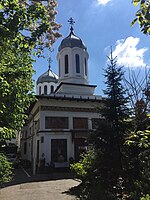Bulevardul Magheru

Bulevardul Magheru is a major street in central Bucharest. Built in the early 20th century, it is named after General Gheorghe Magheru. Together with Bulevardul Bălcescu, Magheru connects Piața Romană and Piața Universității squares and was in the 1930s and 1940s Bucharest's most modern part. This is one of Europe and world's most representative modernist boulevards, where the architecture in vogue in the 1930s is prevalent. Part of the major thoroughfare than runs through the middle of Bucharest, it is continued to the south of C. A. Rosetti Street by Nicolae Bălcescu Boulevard and then by Ion C. Brătianu Boulevard, and toward the north by Lascăr Catargiu Boulevard and Șoseaua Kiseleff. Bulevardul Magheru is one of the most expensive shopping streets in Europe.
Excerpt from the Wikipedia article Bulevardul Magheru (License: CC BY-SA 3.0, Authors, Images).Bulevardul Magheru
Bulevardul General Gheorghe Magheru, Bucharest
Geographical coordinates (GPS) Address Nearby Places Show on map
Geographical coordinates (GPS)
| Latitude | Longitude |
|---|---|
| N 44.442677777778 ° | E 26.098586111111 ° |
Address
First Bank
Bulevardul General Gheorghe Magheru 7
010312 Bucharest (Sector 1)
Romania
Open on Google Maps









